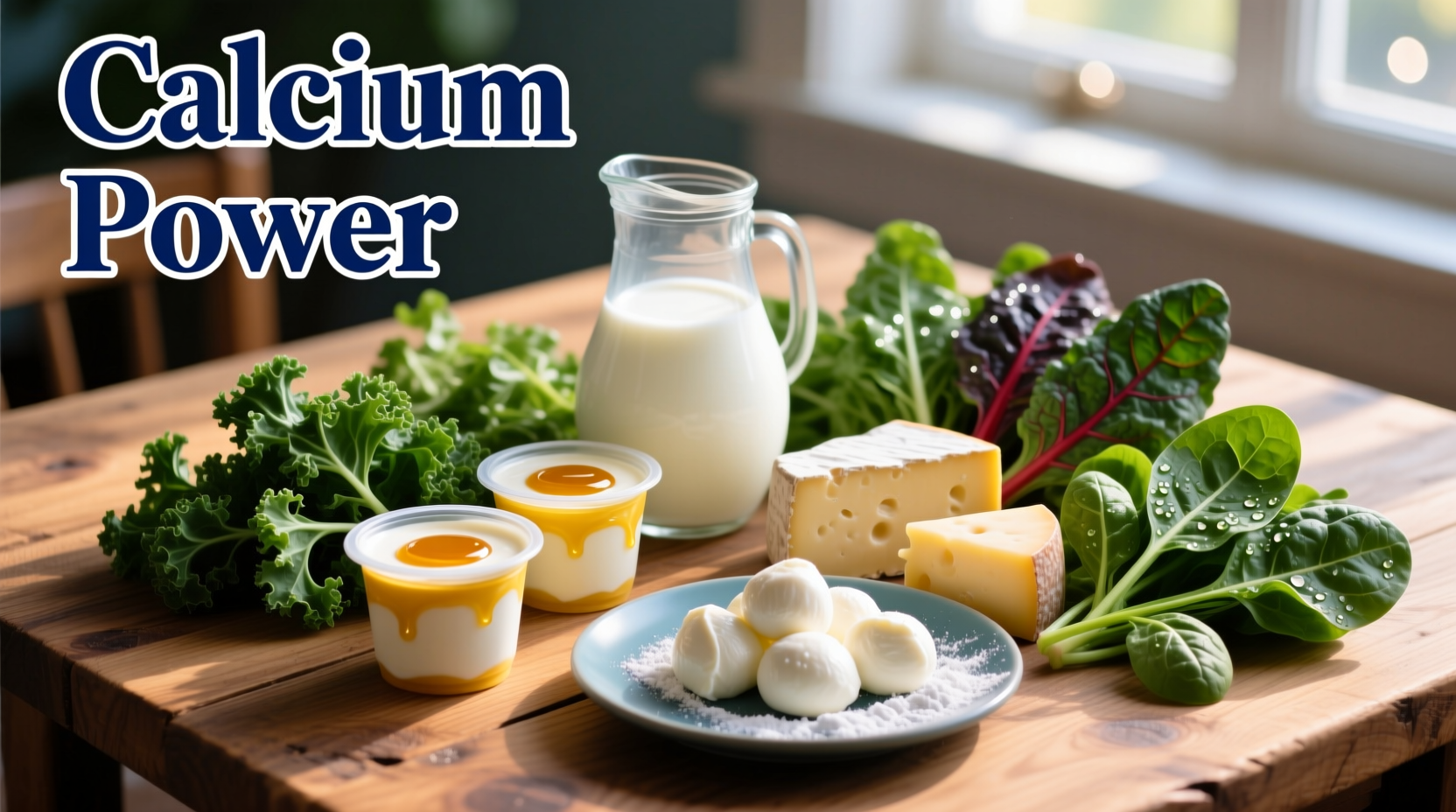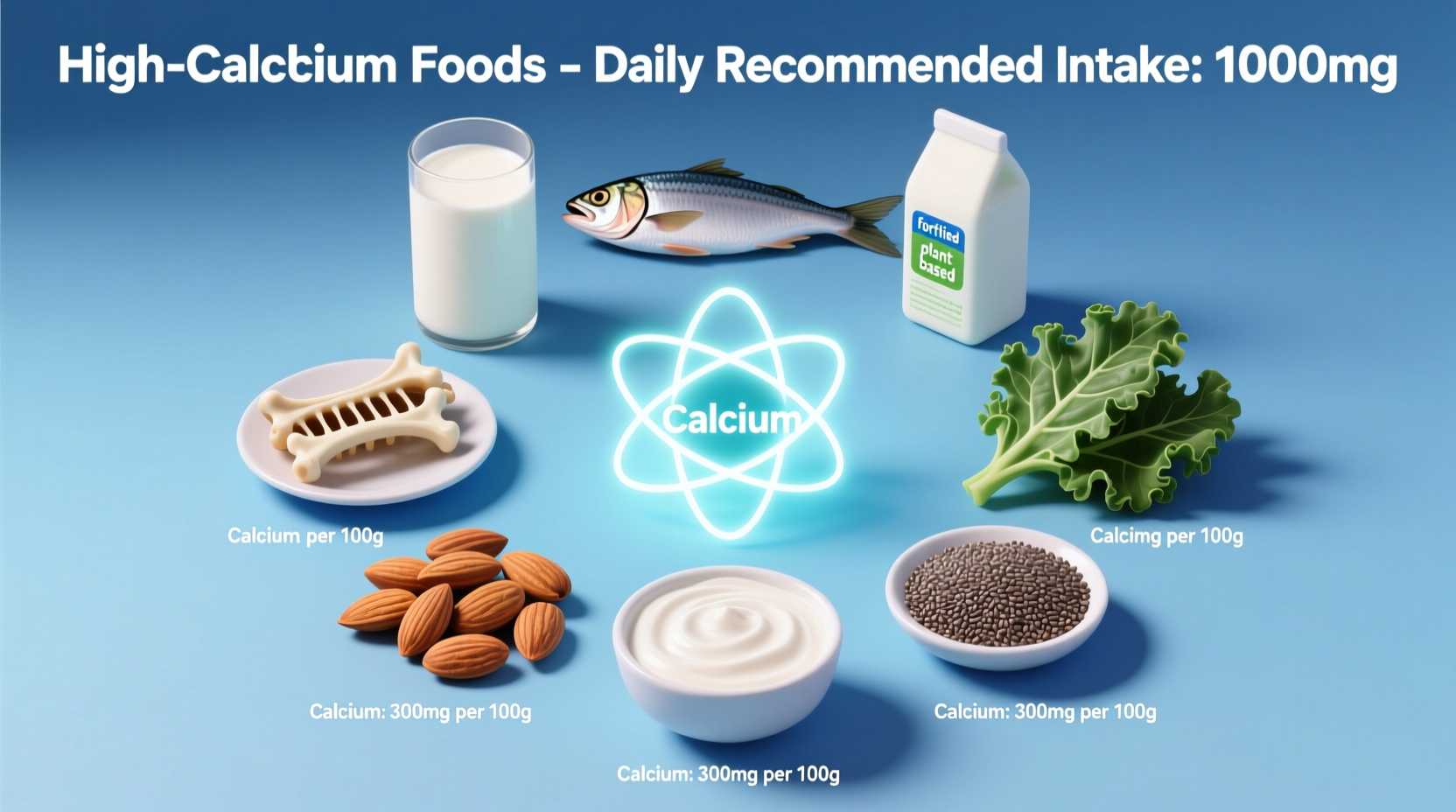Dairy products like milk, yogurt, and cheese top the list of high calcium foods, providing 300-400mg per serving. For non-dairy options, fortified plant milks, canned sardines with bones, tofu made with calcium sulfate, and leafy greens like kale and bok choy offer substantial calcium content essential for bone health and bodily functions.
Calcium isn't just about strong bones—it's vital for nerve transmission, muscle function, and blood clotting. Yet nearly 40% of Americans don't meet daily calcium requirements according to the National Institutes of Health. Understanding which foods deliver the most bioavailable calcium can transform your nutritional strategy.
Why Calcium Matters Beyond Bone Health
While 99% of your body's calcium resides in bones and teeth, the remaining 1% performs critical functions:
- Enables proper muscle contraction and relaxation
- Facilitates nerve impulse transmission
- Supports blood vessel function and hormone secretion
- Aids in enzyme activation for various metabolic processes
Insufficient intake forces your body to leach calcium from bones, increasing osteoporosis risk. The Recommended Dietary Allowance (RDA) is 1,000mg daily for adults 19-50, rising to 1,200mg after age 50 according to the Institute of Medicine.
Dairy Powerhouses: The Most Efficient Calcium Sources
Dairy products consistently rank highest for calcium bioavailability. Your body absorbs about 30% of calcium from dairy sources—higher than most plant-based options.
| Food (1 serving) | Calcium (mg) | % Daily Value | Bioavailability |
|---|---|---|---|
| Plain yogurt, nonfat (8oz) | 450 | 35% | 30-35% |
| Skim milk (8oz) | 300 | 23% | 30-35% |
| Cheddar cheese (1.5oz) | 307 | 24% | 25-30% |
| Cottage cheese (1 cup) | 138 | 11% | 25-30% |
Research published in the American Journal of Clinical Nutrition confirms that fermented dairy products like yogurt enhance calcium absorption due to their probiotic content. For those monitoring fat intake, nonfat dairy options deliver equivalent calcium with fewer calories.
Plant-Based Calcium Champions
For lactose-intolerant individuals or those following plant-based diets, several foods provide substantial calcium—though absorption rates vary due to compounds like oxalates.
Fortified Foods have become game-changers for calcium intake:
- Fortified plant milks (almond, soy, oat): 300mg per 8oz serving (30% DV)
- Fortified orange juice: 350mg per 8oz (27% DV)
- Fortified cereals: up to 1,000mg per serving (77% DV)
Whole Food Sources offer additional nutritional benefits:
- Canned sardines with bones (3oz): 325mg (25% DV)
- Calcium-set tofu (½ cup): 250-860mg (20-66% DV)
- Collard greens (1 cup cooked): 266mg (20% DV)
- Bok choy (1 cup cooked): 158mg (12% DV)
- Almonds (1 oz): 75mg (6% DV)

Calcium Absorption Factors You Should Know
Not all calcium is created equal—your body's ability to absorb it depends on several factors:
Vitamin D Synergy
Vitamin D dramatically enhances calcium absorption. Without adequate vitamin D, your body absorbs only 10-15% of dietary calcium versus 30-40% with sufficient levels. Spend 10-15 minutes in midday sun several times weekly or consume vitamin D-rich foods like fatty fish and egg yolks.
Calcium Inhibitors
Certain compounds can reduce calcium absorption:
- Oxalates in spinach, beet greens, and Swiss chard bind calcium (only 5% absorption)
- Phytates in whole grains and legumes reduce absorption by 20-25%
- Sodium and caffeine increase calcium excretion
Smart pairing strategies can overcome these limitations—consume calcium-rich foods separately from high-oxalate foods, and pair with vitamin C sources to enhance absorption.
Practical Integration Strategies
Transform your calcium intake with these chef-tested techniques:
Breakfast Boosters
Add chia seeds to smoothies (180mg per ounce) or choose calcium-fortified cereals. Whip up a tofu scramble with turmeric and nutritional yeast for 300mg of calcium in one meal.
Lunch & Dinner Solutions
Use tahini (sesame seed paste) in dressings—2 tablespoons provide 130mg calcium. Add canned salmon with bones to salads for an extra 180mg per serving. Sauté kale with garlic and lemon juice to enhance calcium absorption while reducing oxalate content.
Smart Snacking
Pair almonds with dried figs (240mg calcium per half-cup) for a bone-boosting snack. Choose calcium-fortified plant-based yogurt alternatives topped with sesame seeds.
Special Considerations by Life Stage
Your calcium needs evolve throughout life:
- Teens and young adults (9-18 years): Require 1,300mg daily for peak bone mass development
- Pregnant and breastfeeding women: Maintain standard requirements but need careful monitoring
- Postmenopausal women: Need 1,200mg daily due to reduced estrogen's bone-protective effects
- Vegans and vegetarians: Should prioritize fortified foods and low-oxalate greens
For those with lactose intolerance, lactase enzyme supplements can enable dairy consumption. The CDC reports that 68% of the global population has some degree of lactose intolerance, making plant-based alternatives essential for many.
When Supplements Become Necessary
While food-first approaches are ideal, supplements may be needed when:
- Dietary restrictions prevent adequate intake
- Medical conditions impair absorption (celiac disease, inflammatory bowel disease)
- Osteoporosis diagnosis requires higher intake
Consult your healthcare provider before starting supplements. Calcium carbonate requires stomach acid for absorption (best taken with meals), while calcium citrate works well on empty stomachs. Never exceed 500mg per dose—your body can't absorb more at once.
Frequently Asked Questions
Can you get enough calcium without dairy?
Absolutely. Fortified plant milks, calcium-set tofu, canned fish with bones, and low-oxalate greens like bok choy provide substantial calcium. Strategic food combinations and proper preparation techniques maximize absorption from plant sources.
Which leafy greens have the most usable calcium?
Kale, bok choy, and broccoli rabe offer the highest bioavailable calcium among greens. Spinach contains calcium but its high oxalate content limits absorption to just 5%. Cooking methods like steaming can reduce oxalates in some greens.
How does cooking affect calcium content in foods?
Boiling calcium-rich vegetables in water can leach some minerals, but steaming preserves more nutrients. Cooking tomatoes increases lycopene but doesn't significantly affect calcium. Adding acidic ingredients like lemon juice can enhance calcium absorption from plant sources.
What's the maximum calcium your body can absorb at once?
Your body absorbs about 300-500mg of calcium at a time. Consuming more than this in a single sitting results in diminished returns. Spread your calcium intake throughout the day by including calcium-rich foods in each meal for optimal absorption.
Do calcium supplements increase heart disease risk?
Research shows mixed results. Food-based calcium appears safe, while some studies suggest high-dose supplements might increase risk. The American Heart Association recommends obtaining calcium primarily from food sources when possible.











 浙公网安备
33010002000092号
浙公网安备
33010002000092号 浙B2-20120091-4
浙B2-20120091-4